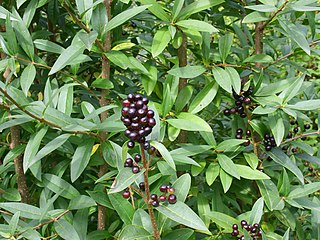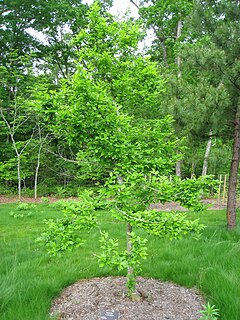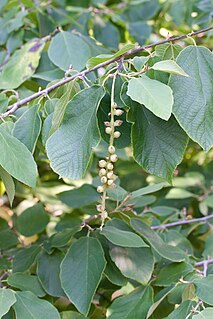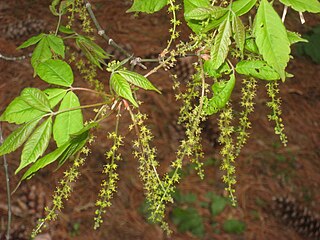
Actinidia is a genus of woody and, with a few exceptions, dioecious plants native to temperate eastern Asia, occurring throughout most of China, Taiwan, Korea, and Japan, and extending north to southern areas of Russian Far East and south into Indochina. The genus includes shrubs growing to 6 metres tall, and vigorous, strong-growing vines, growing up to 30 m (100 ft) in tree canopies. They mostly tolerate temperatures down to around −15 °C (5 °F), and some are much hardier.

A privet is a flowering plant in the genus Ligustrum. The genus contains about 50 species of erect, deciduous or evergreen shrubs, sometimes forming small or medium-sized trees, native to Europe, north Africa, Asia, many introduced and naturalised in Australasia, where only one species extends as a native into Queensland. Some species have become widely naturalized or invasive where introduced. Privet was originally the name for the European semi-evergreen shrub Ligustrum vulgare, and later also for the more reliably evergreen Ligustrum ovalifolium and its hybrid Ligustrum × ibolium used extensively for privacy hedging, though now the name is applied to all members of the genus. The generic name was applied by Pliny the Elder to L. vulgare. It is often suggested that the name privet is related to private, but the OED states that there is no evidence to support this.

Schisandra, the magnolia vine, is a genus of twining shrubs that generally climb on other vegetation. Various authors have included the plants in the Illiciaceae

Semiarundinaria is a genus of East Asian bamboo in the grass family.

Hepatica is a genus of herbaceous perennials in the buttercup family, native to central and northern Europe, Asia and eastern North America. Some botanists include Hepatica within a wider interpretation of Anemone.

Illicium is a genus of flowering plants treated as part of the family Schisandraceae, or alternately as the sole genus of the Illiciaceae. It has a disjunct distribution, with most species native to eastern Asia and several in parts of North America, including the southeastern United States, Mexico, and the Caribbean. General common names include star anise and anisetree. The genus name comes from the Latin illicere.

Lilium henryi, sometimes called tiger lily or Henry's lily, is a native lily of the mountains of central China. The flowers are orange, spotted black, and unscented. The petals are recurving, and eventually resemble those of the more widespread Turk's-cap lily.

Augustine Henry was a British-born Irish plantsman and sinologist. He is best known for sending over 15,000 dry specimens and seeds and 500 plant samples to Kew Gardens in the United Kingdom. By 1930, he was a recognised authority and was honoured with society membership in Belgium, Czechoslovakia, Finland, France, and Poland. In 1929 the Botanical Institute of Peking dedicated to him the second volume of Icones plantarum Sinicarum, a collection of plant drawings. In 1935, John William Besant was to write: 'The wealth of beautiful trees and flowering shrubs which adorn gardens in all temperate parts of the world today is due in a great measure to the pioneer work of the late Professor Henry'.
Henryi, a new Latin adjective used for any of several naturalists named Henry, may refer to:
Alstonia henryi is a species of plant in the family Apocynaceae. It is endemic to China.
Calanthe henryi is a species of plant in the family Orchidaceae. It is endemic to Sichuan and Hubei Provinces of China.
Hemipilia henryi is an endangered species of plant in the family Orchidaceae native to the Hubei and Sichuan provinces of China.

Sinojackia is a genus of five to eight species of flowering plants in the family Styracaceae, all endemic to China.

Sinowilsonia is a monotypic genus of plant containing the single species Sinowilsonia henryi. It is endemic to China. It is threatened by habitat loss. It is available from specialized commercial nurseries.
The Jardin botanique du col de Saverne, also known as the Jardin botanique de Saverne, is a botanical garden and arboretum located along the Col de Saverne near Saverne, Bas-Rhin, Alsace, France. It is open on weekends, and daily in the warmer months; an admission fee is charged.
Allium henryi is a plant species native to Hubei and Sichuan, China. It grows on hillsides at elevations of 1300–2300 m.
Sindechites is a genus of flowering plants in the family Apocynaceae, first described as a genus in 1888. It is native to southern China, Laos, and Thailand.
Iris henryi is a beardless rhizomatous iris. It is in the genus Iris, subgenus Limniris and in the series Chinenses of the genus, from China. It has thin green leaves, short stem and light-blue, to creamy-white or pale yellow flowers.

Acer henryi is an Asian species of maple. It has been found only in China.

Lonicera acuminata, commonly known as fragrant grove honeysuckle or vine honeysuckle, is a plant species of honeysuckle native to China to Southeast Asia and India.













